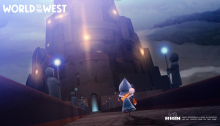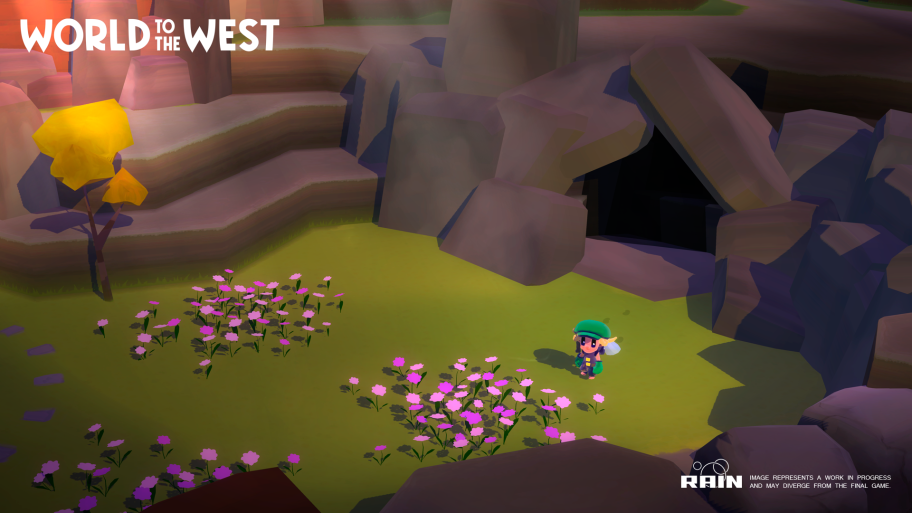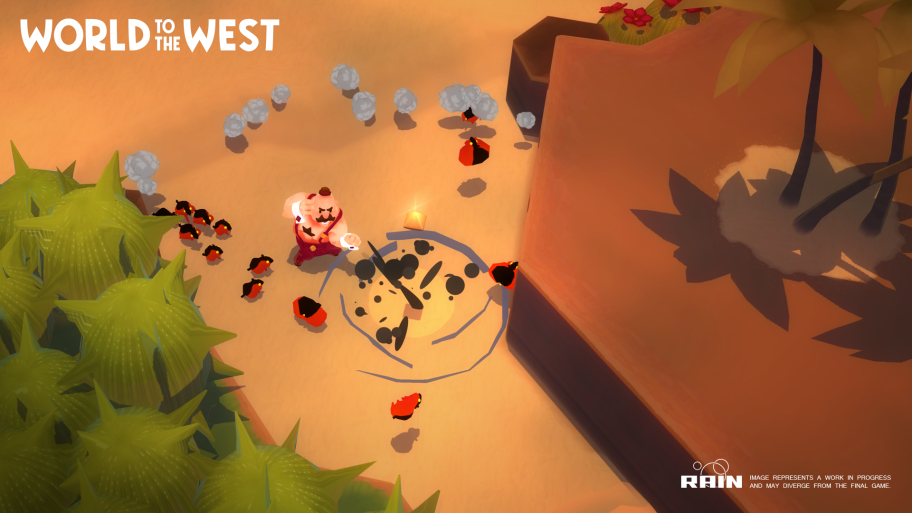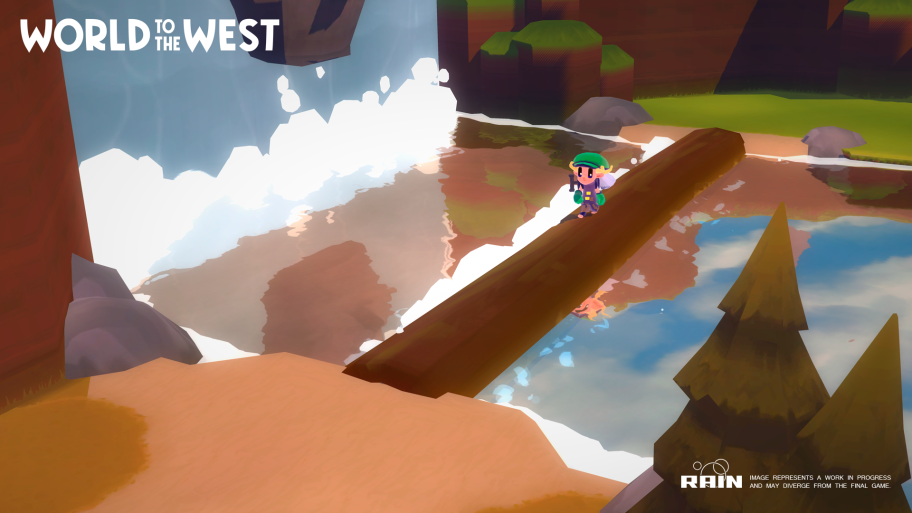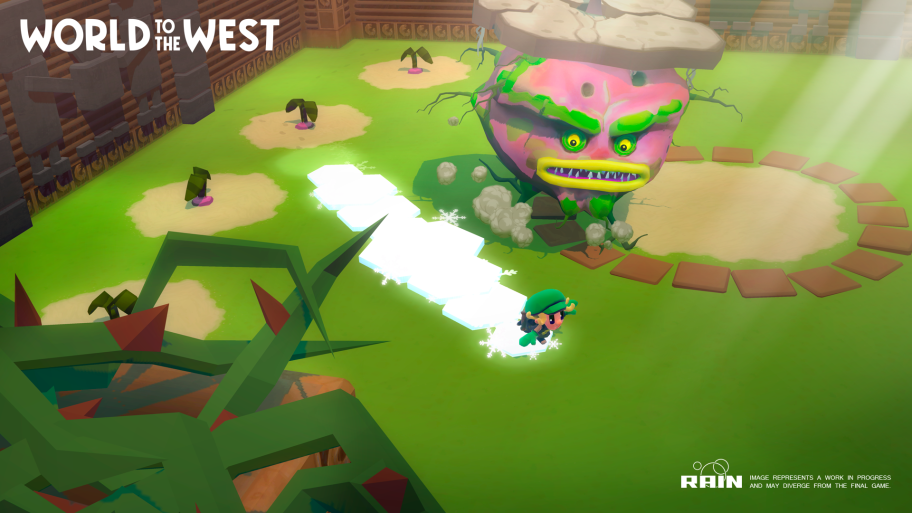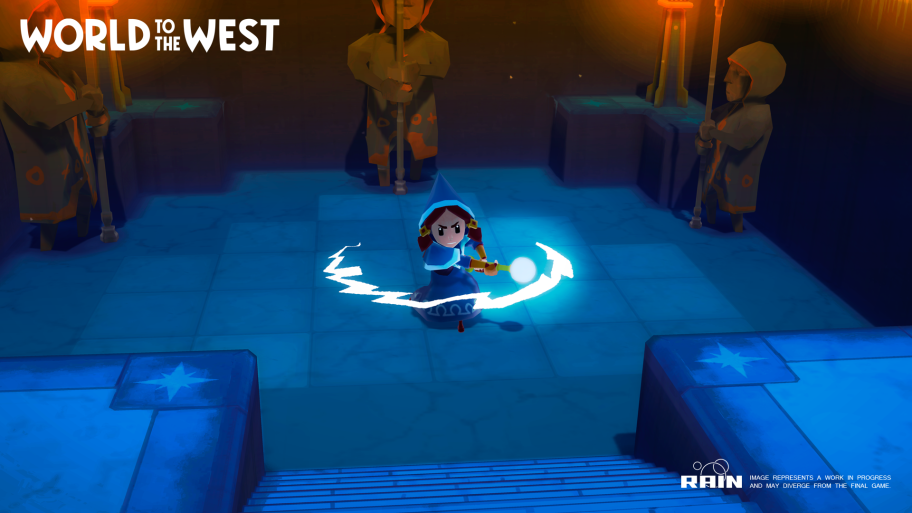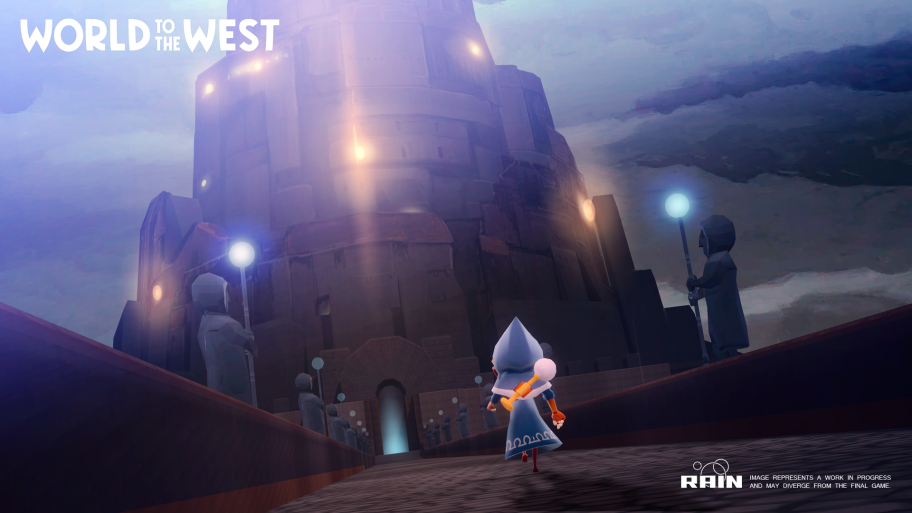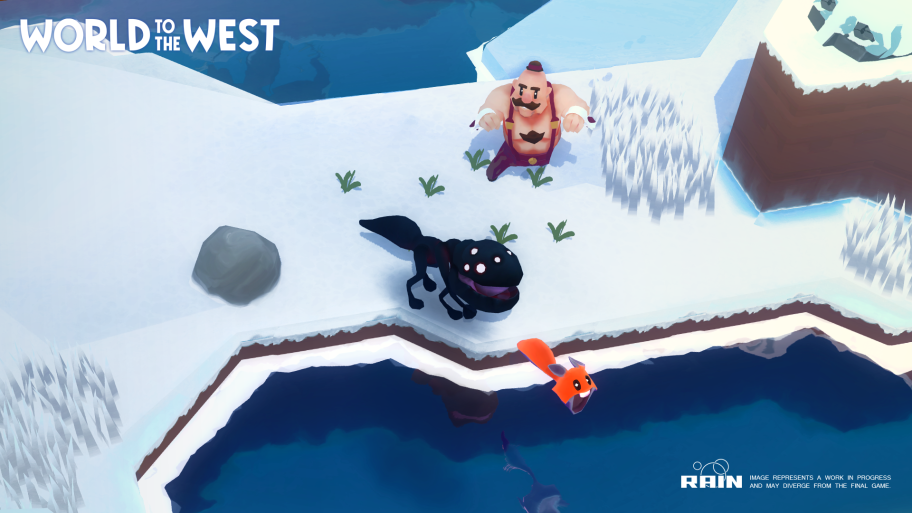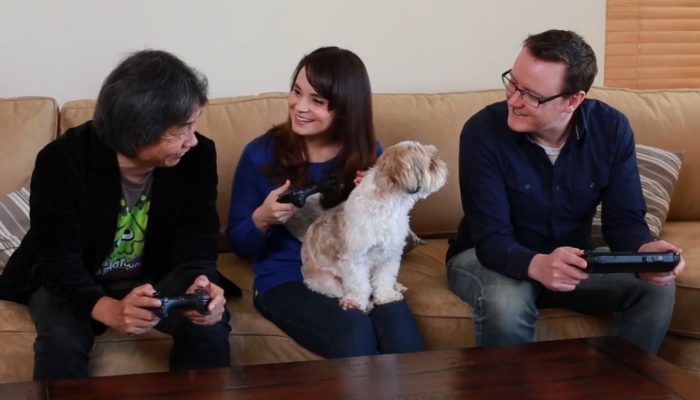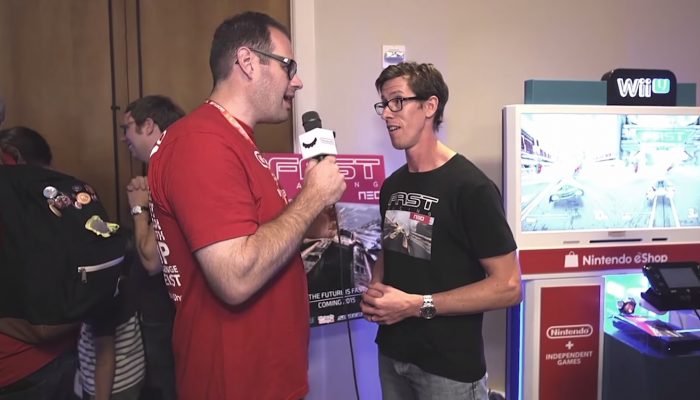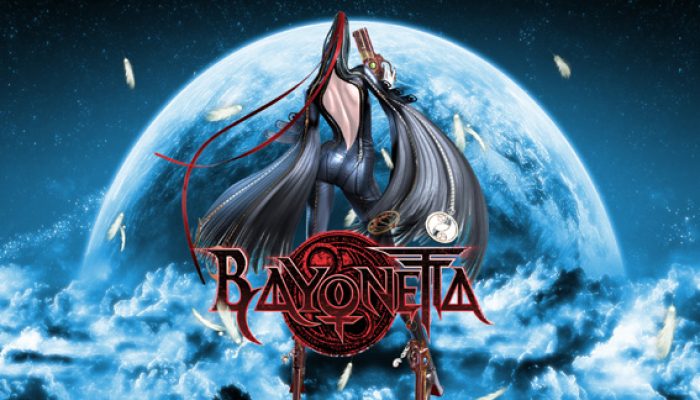 “The main character of Teslagrad does actually have a name – we’ve just never told anyone.”
“The main character of Teslagrad does actually have a name – we’ve just never told anyone.”
☆ NintendObs Weekly – Monday, September 12, 2016 – Sunday, September 18, 2016.
Nintendo eShop Developer Discussion: Rain Games on World to the West
How a team of ten is putting a new perspective on an ancient world.
Version française ici : Discussion avec un développeur du Nintendo eShop : Rain Games nous parle de World to the West. 😉
15/09/2016
World to the West is an upcoming action-adventure game from independent developer Rain Games, the creators of Teslagrad on Wii U. In this interview from gamescom 2016, we chat to CEO Peter Meldahl about the game’s unique roster of characters, the mysterious world they inhabit and the works that inspired it.
Nintendo of Europe: Could you please introduce yourself to our readers and explain your role within the company?
Peter Meldahl: My name is Peter Meldahl, and I’m the CEO of Rain Games. We’re a small company with about ten employees. In addition, we have some external staff working on sound design, but just ten staff at the office – we’re a long way away from being considered a big company.
Other than being the CEO, I also do all of the level design, write the overarching storylines for our games and lead our development team. I know how to code, but I’m not a coder – I would be terrible, and we already have three excellent programmers.
NoE: We’re talking about your new game, World to the West. Could you please explain what kind of game it is, and what it’s all about?
PM: It’s about exploration, largely. We’ve taken the world that we created in Teslagrad and introduced three new characters from other parts of the continent. The game world is basically a simplified version of Europe, inspired by four countries. It’s a fantasy world, but it really has that real-world European vibe to it.
This is an exploration of a new continent, so the world is as mystical to the characters in the game as it is to you. The world has experienced a true apocalypse, but because the civilisation that once stood there was way more advanced than anything in the real world today, it still contains these secrets of amazing power. Unfortunately, a lot of them have been lost to the ages.
NoE: We’ve seen there are four different characters in the game. Can you tell us a bit more about them and their unique powers?
PM: Each character’s powers are closely related to their personality and the nation they’re from. Lumina is a really powerful Teslamancer, so she can control electricity and magnetism. She plays very similarly to her father, who was actually the main character in Teslagrad. It’s very interesting because you get to explore the moveset again, but the perspective has shifted from side-scrolling to top-down.
Then there’s Lord Clonington, also known as the strongman. He’s bombastic – whenever he’s presented with a puzzle, he just smashes through it, literally! He believes he’s doing the world a favour by being this great explorer and discovering all these things. More than anything, he wants to prove to people that he can make it as an adventurer.
Knaus is one of the many mining children that was sent from a very industrialised nation in an attempt to reach the moon. In the beginning, he gets a shovel, and it’s pretty useful because he can use it to tunnel into any soft piece of earth and get around enemies. He’s also able to crawl into lots of places that are just too small for the other characters to get in. He gets to play around with the most powerful weapon in the game – dynamite! – and he later acquires a set of skates that makes him able to freeze water and move over it freely.
Finally, we have Terri, the Mindbender. The nation she hails from is all about art, design and artistic expression. She has access to technology that’s all about manipulation, and she can make every monster in the game do what she wants. However, she has a moral code which means she doesn’t use her powers of manipulation on people – only on the monsters. She can also fire an electric ball as a weapon and use it to teleport short distances. It also explodes when she reappears, so it’s a very powerful ability.
NoE: Is there a story that brings all of these characters together? Can you switch between them at any time?
PM: In the beginning, every character has a very specific goal. At this point, you’re still learning the basics of the gameplay and discovering the opening moments of each character’s story, so you only get to play with one character at a time.
They’ll eventually pair up to have little adventures together. Even though they team up, each character is still pretty independent in the sense that their adventures are about very different things, and they each have very different motivations. Eventually, it all weaves together into a single story, and that’s when you gain the ability to switch between all of the characters seamlessly.
NoE: Are there lots of different ways to approach things? Could you play through the game a second time and do things differently?
PM: Yeah, definitely! The opening parts are pretty set in stone, and there’s a good reason for that, but as you progress, you can do a lot of stuff differently. Once you reach the halfway point, you can do pretty much everything in very different ways. There are a few things that you always have to do as a certain character so that we know you haven’t forgotten they exist, but there’s a lot of flexibility there.
NoE: Can you give us an example of how the characters might be used to solve puzzles?
PM: For Terri, it’s simply a case of getting access to the right abilities by controlling monsters. Obviously, you’re limited by the monsters that are present in the area, and the abilities they possess. You might actually have to use one monster to get hold of another before you can progress.
Lord Clonington’s challenges are always physical. His problem is that he’s not able to avoid anything, so he has to take every confrontation head-on. There are many instances where you can’t progress until you’ve defeated every enemy in sight, so his challenges aren’t very mindful, but they can be mechanically challenging in the sense that you actually have to be skilled in combat. There are some fights later in the game where we really wanted to challenge the player, though some of them are optional.
NoE: Are there lots of secrets hidden in the game?
PM: We like to be fair about these things, but we also don’t want to reward everything. If you did something difficult or clever, you can have a secret, but we don’t just put one in every corner of the map. In Teslagrad, we hid 36 scrolls away behind paintings, and these paintings told a story of the past. We’re going to do something similar for this game, so you’ll be able to find these pieces of the past which will tell the story of the continent, rather than the story of the characters.
NoE: What kind of works inspired World to the West?
PM: Tons! Of course, there’s a direct inspiration from Teslagrad with Lumina and the historical city of Teslagrad itself. There’s also a lot of inspiration from old Steampunk works – a lot of misconceptions about science and technology.
We wanted to take the style of Teslagrad – which was much darker – and bring it into this 3D world, but still have everything look like it’s a cartoon. That’s one of the reasons we used the top-down perspective, which itself was inspired by the old The Legend of Zelda game.
NoE: As the creators, you can make the game look however you want. What inspired you to pursue this particular art style?
PM: Olli is our art director, and he has a certain way of doing things. For instance, his philosophy of designing a character is really interesting. First, he’ll draw the character several times over, and then leave it alone for a few days. Then, he’ll come back to it and start drawing that character again, and all of the little details that he forgets to draw this time around were never really important in the first place. It’s a way of simplifying character design down to the things that people can easily remember, and so it’s all about simplicity.
This philosophy carries on into everything else that we do, and propagates into the world itself. You want things to be striking, have scale and seem grand, but you also want to keep them simple, so any unnecessary complexity should be avoided.
NoE: What kind of Wii U features are you taking advantage of?
PM: With Teslagrad, the best version of that game was on Wii U, for sure. I love off-TV play a lot, and World to the West supports that feature, too. Wii U also gives us the possibility of having the map on the Wii U GamePad, which is very nice. There’s a lot of navigation in this game, so you really do need a map, and the fact that you can see it at all times really helps.
NoE: Speaking of which, the map in this game works in a very interesting way. Can you tell us a bit more about it?
PM: It starts out as a very simple sketch with really big paint strokes, so it’s very blotched. It’s as if an explorer just saw the area from the sky or from a faraway mountaintop – they might have a basic idea of how it looks, but they’ve never actually been there. Initially, it’s like somebody’s drawn a map from a set of rumours, but when you eventually go into that area, the drawing becomes much more clear and detailed.
NoE: We’ve also heard something about an underworld. Can you explain how it works?
PM: Almost every tiny cave or nook and cranny in the underworld is connected to the world above. In the beginning, you might only investigate these caverns a little bit, but as you get the ability to destroy rocks, climb over obstacles and skate over the water, different characters are able to take different routes through this underworld.
It’s a very different place to the overworld, and many of the areas are completely optional. It might just be a shortcut from one area to another that we don’t ever specifically make you take. There are secrets and mysteries and monsters down there, and it’s about having the desire to go and explore. Of course, there might be ways to get from one side of the map to the other much more quickly than usual, but there’s a bit more to it than that.
NoE: Are there any throwbacks to Teslagrad in World to the West’s story?
PM: In the introductory scene, you’ll see the main character from Teslagrad looking into the middle distance on the bridge of Tesla Tower, but now he’s all grown up. He’s wondering about the state of his current nation, because, with their old leadership gone, he’s had to fill the void and it’s not been easy. He’s married and has children now, but he’s busy ruling the nation, so he doesn’t get to see them a lot.
When the menu screen fades out, you see him start to walk towards the tower, and you hear somebody shout “Dad!” off-screen. It’s Lumina. She runs after him, trying to catch up, but then the perspective shifts from that side-scrolling style you saw in Teslagrad, to the top-down camera that we use for World to the West.
NoE: What led you to change the perspective for this game?
PM: Our belief is that something great is, almost without exception, a mix of something new and something old. We thought, “If we’re going to keep the world and the characters from Teslagrad, then we should definitely change something about the game.”
During the development of Teslagrad, we had a lot of ideas where we thought, “Oh, we can put that in the sequel!”, and they were all okay ideas, but they weren’t great. We’d used all the great ideas the first time around. We didn’t want a collection of all our second-best ideas for the Teslagrad universe.
NoE: You didn’t want to create a B-sides album, basically.
PM: Exactly! We could have kept it mechanically the same and just built on the graphics engine to do more visually impressive stuff, but I think you have to change things up a bit more than that. Take the Super Mario games, for example – no two games in that series are the same, and it’s a very good philosophy.
NoE: What’s next for Rain Games after World to the West?
PM: We’re going to make more games in this game’s universe, for sure – we want to keep exploring this universe and keep the world progressing. One of the reasons we made exploration such a big part of this game is that we get to show off all four of our nations at once. In Teslagrad, everything happened in one nation – Electropia – and Teslagrad is the capital of that country, but nobody knows that because we’ve never told anyone.
We have a storytelling philosophy that we should know way more about the world than we’re ever going to tell anyone. Storytelling is a very precious resource, and we should try to keep words to a minimum. As the creators of the game, we know everything about the world itself, but the players only get to know as much about the world as the characters know. For example, the main character of Teslagrad does actually have a name – we’ve just never told anyone.
NoE: He does?! Oh, come on, tell us his name!
PM: No! (laughs)
NoE: Will we find out his name in World to the West?
PM: You’ll get to know his name when it’s appropriate.
NoE: I see, very cryptic! Are there any more Easter eggs or secrets you’d like to share with us?
PM: Well, the game isn’t finished yet, and Easter eggs are always things that we might put in or take out at the last minute, but there’s a couple I can tell you about. One of the collectible cards in World to the West hints at the origins of the Tesla Monsters’ technology, and how they might have acquired it. Also, in the secret ending of Teslagrad, there were a lot of characters in the city. You might be seeing a bit more of two of them…
NoE: I see! Now, for a bit of fun – if you were Terri, which creature would you control first?
PM: The game world has a lot of fast-moving creatures to control. For example, Slapsquatch is a giant, big-handed ape creature, and it’s able to carry Terri around. It places her on its back and climbs up mountains. They can get everywhere! You could sit on its shoulders and just say, “Go over there!”
NoE: Finally, if you could choose to have any of the characters’ abilities, which one would you pick?
PM: Lumina’s powers are great. Just imagine being able to zip-zap across this entire convention!
NoE: I think that pretty much wraps up our questions. Thank you very much for speaking to us today, it’s been an absolute pleasure.
World to the West will be available to download from Nintendo eShop on Wii U in Q1 2017. If you want to discover more about the game’s world, Teslagrad is now available to download from Nintendo eShop on Wii U.
— Nintendo UK News
Source: Nintendo UK.
At NintendObserver, the comments are on Discord.
Click on Community to learn more. 🙂
…
…Wanna play? Buy a Wii U.
And if you’ve already got yours, click on World to the West for everything you need to know about the game. 😀
